The Checker Maven
The World's Most Widely Read Checkers and Draughts Publication
Bob Newell, Editor-in-Chief
Published every Saturday morning in Honolulu, Hawai`i
Noticing missing images? An explanation is here.
Breaking Even: A Taxing Problem
Sometimes, breaking even is the best you can do.

That is never more the case than when dealing with the United States Internal Revenue Service. And the publication date of this article, April 15, 2006, is the traditional American tax day, on which income tax returns --- and final payments --- fall due.
Keeping that theme in mind --- of doing everything you can to just break even --- take a look at today's feature problem.

BLACK
Black to Play and Draw
B:W28,26,24,K3:B19,15,14,2.
Forces are even, but White has a king and Black is going to have to struggle just for a draw.
Tax your brain, then file your solution before paying up by clicking on Read More to see how it's done.![]()
The Bear Trap Is Still Empty

Brian Hinkle's challenging Bear Claw problem (click on the link to see it again) is still unsolved, and so Brian is raising the bounty to $50. He has asked that we not publish the solution until the bounty is claimed. If you think you have the bear in your trap, send your solution to Brian right away.![]()
This prize is offered by Brian Hinkle and will be awarded at his sole discretion and judgment. The Checker Maven does not offer or guarantee this prize. Offer void where prohibited, taxed, or restricted by law. Staff and relatives of staff of any of the Mr. Fred Investments group of companies are not eligible to participate.
KingsRow Continues to Dig

Ed Gilbert has set his KingsRow engine and 10 piece endgame database on the path of more deep discoveries as he continues to mine interesting problems. Here's a sample of some of the things Ed has unearthed:
- As long suspected, the alternate jump in the Single Corner (11-15 22-18 15-22 26-17) is a draw. Ed cautions us that his findings don't constitute absolute proof, but his new computer opening book shows a draw against virtually all lines of attack.
- Elbert Lowder's 13-17 defense in the Will-o-the-Wisp is a very narrow draw.
- The new book contains some interesting Switcher lines like play after 11-15 21-17 9-13 25-21 8-11 23-18 4-8.
- Ed has searched for alternate lines in the Double Cross. The book confirms that after 9-14 23-18 14-23, then 26-19 is indeed a loss. Also, after 9-14 23-18 14x23 27x18 12-16, then only 18-14 draws, and all others are almost certain losses.
- How about drawing lines in the dreaded Edinburgh? The book shows that after 9-13 22-18 6-9 18-14 xx, there are three moves to draw: 12-16, 11-15, and 1-6.
- The book makes an end of this "ash can" line: 10-15 22-17 15-19 24x15 11x18 23x14 9x18 26-23 6-9 23x14 9x18 30-26 5-9 17-14 1-5 21-17 9-13 25-21 3x22 26x17.
- And similarly, the book finishes off this GAYP line: 11-15 24-19 15x24 27x20 9-14 23-19 8-11 26-23 11-15 22-18 15x24 18x9.
- Ed looked into the 27x20 jump in the Waterloo opening: 11-15 23-18 8-11 18-14 9-18 24-19 15-24 22-8 4-11 and now if 27-20 instead of the normal 28-19, the draw is tough, but it is there.
- Perhaps most exciting of all, Ed has found five new drawing lines in the Black Hole!
See for yourself; you can download this special opening book, for use with KingsRow and CheckerBoard, from Ed's web site here.
Thanks to both Ed Gilbert and Brian Hinkle for providing us with input for this story.![]()
Checkers 2006

We recently received our copy of the International Checker Hall of Fame annual, Checkers 2006, and it's something not to be missed. Once again, Charles Walker and staff have put together over 300 pages of sprawling, rambling checker play, history, and lore, including, we modestly point out, a lengthy extract from our own web site.
To get a copy, send $30 for delivery to US addresses, or $40 for international shipping, to ICHF, Box 365, Petal,MS 39465. Be sure to order right away, before a sellout takes place.
We're delighted that, in spite of the challenges in his personal life, Mr. Walker was able to produce another book that checker fans everywhere will treasure. We know Mr. Walker now faces some dark days, and our thoughts are with him. We can only hope that these days soon will yield to a brighter future for a man who has done so much for our game.![]()
Typesetting Problem Causes Release Delay

We should have known better, but we upgraded our typesetting software and the inevitable happened: we ran into some serious problems which caused an unacceptable loss in diagram quality.
We've since resolved the issues, and the diagrams look better than ever, but the loss in production time set back our scheduled electronic release of Richard Pask's Key Themes from mid-April to sometime in May.
We apologize to our readers for this delay. We can only promise that the wait will be well worth it.![]()
Finishing the Job

As yet another teaser from our very soon to be released electronic republication of Richard Pask's Key Themes, we bring you a situation that Mr. Pask takes as far as a Black win, but leaves it to you to finish the job.
Here's a runup to the diagram:
| 1. | 10-14 | 22-18 |
| 2. | 11-15 | 18x11 |
| 3. | 8x15 | 24-20 |
| 4. | 6-10 | 28-24 |
| 5. | 1-6 | 23-19 |
| 6. | 9-13 | 25-22 |
| 7. | 6-9 | 29-25 |
| 8. | 4-8 | 26-23 |
| 9. | 14-17 | 21x14 |
| 10. | 9x18 | 23x14 |
| 11. | 10x26 | 31x22 |
| 12. | 7-10 | 25-21 |
| 13. | 8-11 | 27-23 |
| 14. | 5-9 | 23-18 |
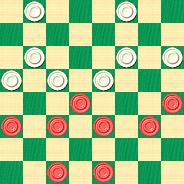
BLACK
Black to Play and Win
B:W32,30,24,22,21,20,19,18:B15,13,12,11,10,9,3,2.
Can you find where White went wrong, and correct the play, and then can you find the winning move for Black and finish the job?
When you think your work is complete, finish off by clicking on Read More for solution and commentary.![]()
So What, and Big Deal

This is a busy week, as our second feature article contains two substantial problems, related in a way that will become clear later on, and sharing a common thread of thought: at first glance, you're likely to say "So What" or even "Big Deal."
But these problems are the compositions of that noted problemist of a bygone era, Mr. Chas. Hefter, a checker force not to be taken lightly, so perhaps we should avoid hasty judgments.
Here's the first one:
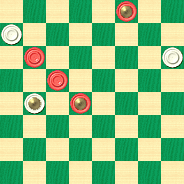
BLACK
Black to Play and Draw.
B:W28,21,K16:BK30,24,19,K15.
Well, "So What?" Black is a man up and we're just asking for a draw... oh... wait.... Black is about to lose a man and... a second one... so Black will be a man down... hmm, maybe there is something to this after all.
And now the second situation:
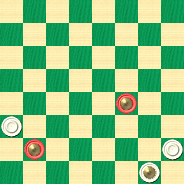
WHITE
White to Play and Win
W:W21,28,K32:BK19,K25.
So, "Big Deal." White is a man up and what else should he do but win? Oh.... the king and man jammed into the double corner could make it harder... hmm, maybe it's not as easy as it first looked.
Try out the problems but if you are stumped, so what. Clicking on Read More to see the solutions is no big deal.![]()
Today Is The Day
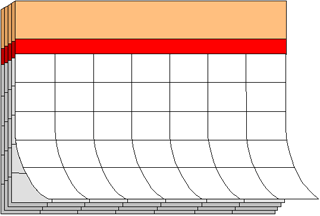
Some of our problems, we admit, can be on the tough side, especially for the average player. But today, we'll give you a checker problem that is easier than you might think:

WHITE
White to Play and Win
W:W22,26:B9,10,13
Can you find the trick that gives White the win? Today's the day for you to solve this problem!
Click on Read More for the surprising solution.![]()
What's Your Hurry?

To open the month, we've chosen a speed problem that may take you a bit longer than some of the others we've run in the past. In fact, we were right on the edge in our decision as to whether or not this is a true speed problem; but the solution is simple and snappy... once you see it.
You know the drill. Click below to show the problem and start the clock. We've allowed you three minutes on this one, but what's your hurry?
We're sure of one thing, though; we know you won't lose any time clicking on Read More to reveal the solution.![]()
A Sports Bar Debate
There was a big Sunday afternoon crowd at the Mojo Sports Bar in downtown Detroit. Glasses and bottles were everywhere to be seen as the crowd buzzed over a just-completed exhibition match, narrowly and unexpectedly lost by the hometown Major League team, the Detroit Doublejumpers, to the Bridgeport Breeches of the AAA Northeastern League. The match, of course, was viewed on the bar's large-screen TV, and broadcast by the Checker Television Network.
In the final round, Detroit captain Marvin J. Mavin had lost his first-board game to Bosco della Bruggia of the Breeches, costing the Doublejumpers the match. The network commentators thought the game wasn't all that well played; and they felt Marvin had missed a last-ditch draw. Some of the bar patrons agreed with this assessment, but they were in turn opposed by a number of the other patrons, who, as fierce hometown supporters, backed Marvin avidly.
A large group was gathered around a table where a pair of fans were going over the game. One of the onlookers, Johnny Jack Jackson by name, had played some semipro checkers a few years back, and was generally held to be the bar's champion (he would play for a beer and rarely went home sober). Johnny was commenting on the game as the moves were run up.

Johnny Jack Jackson Does the Play-By-Play
11-15 23-18
8-11 18-14
"Most of 'em plays 27-23 or some of 'em plays 26-23. 18-14 is a little different but it's OK. I seen it before from that guy Ed Queensline who plays AA checkers for Morristown out in Jersey."
9-18 24-19
15-24 22-8
4-11 27-20
"Aw c'mon Marvin, you oughtta capture toward the center with 28-19."
10-15
"I wouldda played 5-9 but this ain't so much worse."
... 28-24
"25-22 or maybe 21-17 .... you're givin' Bosco the edge here, Marv!"
6-10
"Now, I'd a played 5-9 right away. I 'spose Bosco was goin' for that element of surprise bit."
... 26-23
"Marvin, you give 'em a little on each move! You still couldda played 25-22. You probably got a loss now, pal."
5-9 21-17
9-14 25-21
15-18 ...
"Marv, I'd say you got a real big problem.... like, you lose!"
... 32-27
18-22 30-26
"Some a you guys wouldda played 30-25 instead, but after 1-6 it ain't so great. It's a two for two and Black gets an even easier win."
1-6
"What a stinko move, Bosco! 11-15 wouldda nailed down the game but now Marvin's right back in there."
17-13
14-17 21-14
10-17 23-18
7-10
"We're headed straight for a draw now."
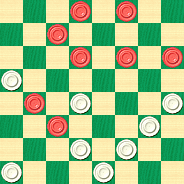
WHITE
White to Play and Draw
... 18-14
"Marvin, you're a dumb bum! You blew it---- again!"
11-15
"Well, OK there Bosco, you still win just fine, but I kindda like this line: 12-16 14-7 3-10 26-23 10-15 23-18 6-9 13-6 2-9 27-23 17-21 game over."
... 14-7
3-10 27-23
10-14 23-19
6-10 13-9
14-18 9-5
18-23 5-1
23-20 Black Wins.
"So our boy Marvin runs into an early loss but then Bosco plays a bonehead move and puts Marv back in the game. Does he get his draw? Noooo! He's gotta blow it away a second time with that 18-14 move! Ahhh.... it wasn't such a great game anyhow. Exhibitions, they just goof around sometimes instead a playin' serious."
Loud discussion ensued, with some thinking that 18-14 was indeed the best move and others not so sure. But Johnny insisted, and pretty soon little groups around the bar were playing out the variants and wagering a few tall cool ones on the results.
What do you think? Could Marvin have saved the draw? Would you be willing to bet Johnny a beer (or two) on your answer?
Click on Read More when you've decided.![]()
The Checker Maven is produced at editorial offices in Honolulu, Hawai`i, as a completely non-commercial public service from which no income is obtained or sought. Original material is Copyright © 2004-2025 Avi Gobbler Publishing. Other material is public domain, AI generated, as attributed, or licensed under CC1, CC2,CC3 or CC4. Information presented on this site is offered as-is, at no cost, and bears no express or implied warranty as to accuracy or usability. You agree that you use such information entirely at your own risk. No liabilities of any kind under any legal theory whatsoever are accepted. The Checker Maven is dedicated to the memory of Mr. Bob Newell, Sr.

